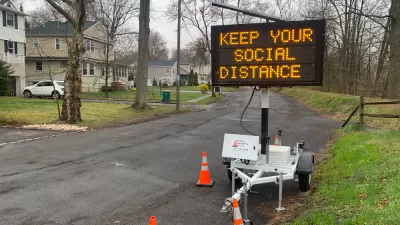Rising land values has made some of the land Sydney, Australia's affordable housing sits on prime targets for redevelopment and gentrification.

Residents in some of Sydney's public housing are being forced out of their homes as the city looks to sell off the land to fund new housing development elsewhere. The South China Morning Post reports that public housing in the suburbs of Red Fern, Millers Point, and Waterloo are all scheduled for redevelopment, leaving many of their residents feeling unmoored from the communities they have lived in for years. The sell-off is part of a government strategy to increase density on the site of the public housing, taking advantage of the steep increase in property values to help fund new public housing in other locations. The Morning Post article notes that after Hong Kong, Sydney is the second least affordable housing market in the world.
This has sparked a government strategy affecting Millers Point and Waterloo: trade valuable inner-city social housing – never quite as dense as it could be, occasionally in disrepair – for newer, cheaper, more numerous housing elsewhere, easing the state’s 60,000 person-strong waiting list.
According to the state government, the sale of Millers Point alone will raise A$500 million and fund 1,500 new social housing dwellings in the city’s outer western suburbs. But to many, surging rents and the public eradication of the city’s few high-profile housing estates give the impression that inner Sydney is no longer a place where poorer people can live.
The government has promised that all of the residents will be able to return to the neighborhood once redevelopment is complete, however many are worried that the services they have relied on, including drug counseling services, will have no home in the newly gentrified community.
FULL STORY: Sydney’s last stand: the residents holding out against gentrification

Planetizen Federal Action Tracker
A weekly monitor of how Trump’s orders and actions are impacting planners and planning in America.

Maui's Vacation Rental Debate Turns Ugly
Verbal attacks, misinformation campaigns and fistfights plague a high-stakes debate to convert thousands of vacation rentals into long-term housing.

Restaurant Patios Were a Pandemic Win — Why Were They so Hard to Keep?
Social distancing requirements and changes in travel patterns prompted cities to pilot new uses for street and sidewalk space. Then it got complicated.

In California Battle of Housing vs. Environment, Housing Just Won
A new state law significantly limits the power of CEQA, an environmental review law that served as a powerful tool for blocking new development.

Boulder Eliminates Parking Minimums Citywide
Officials estimate the cost of building a single underground parking space at up to $100,000.

Orange County, Florida Adopts Largest US “Sprawl Repair” Code
The ‘Orange Code’ seeks to rectify decades of sprawl-inducing, car-oriented development.
Urban Design for Planners 1: Software Tools
This six-course series explores essential urban design concepts using open source software and equips planners with the tools they need to participate fully in the urban design process.
Planning for Universal Design
Learn the tools for implementing Universal Design in planning regulations.
Heyer Gruel & Associates PA
JM Goldson LLC
Custer County Colorado
City of Camden Redevelopment Agency
City of Astoria
Transportation Research & Education Center (TREC) at Portland State University
Jefferson Parish Government
Camden Redevelopment Agency
City of Claremont





























